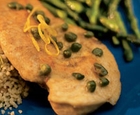|
Italian Entree Chicken Lemon Piccante Tart, buttery and delicious. These scallopinis of chicken are napped in a capered, lemony sauce.
Chicken: slice chicken breasts in half lengthwise. Or if you're in possession of a good sharp knife, slice the breasts edge-to-edge (like cutting a deck of cards) to make two thin pieces. Place each half (however you cut slice them) between 2 sheets of waxed paper and pound to 1/4" thickness (use a mallet, or heavy chef’s knife blade). Set aside. Coating: combine flour with next 4 ingredients, plus 2 tsp. lemon zest. Coat flattened chicken breasts with the flour mixture. Set pieces on a flat baking sheet and let them rest for 30 minutes before cooking. This helps seasoned flour to adhere. Saute: use a heavy skillet to heat oil and butter until very hot (careful not to burn). Add chicken pieces, batch at a time, and brown 3-5 minutes a side (till chicken is cooked but still tender). Add more oil if you need it. Remove, arrange on a platter, and keep warm. Sauce: next, add garlic to skillet and cook 2 minutes (careful not to brown). Then add lemon juice, wine, and capers, stirring and scraping up meat fond from bottom of the pan. Boil down a few minutes, always stirring, to thicken slightly, and pour over chicken. Garnish with parsley and serve immediately. |
Tips & Glossary Arborio Rice: a medium-grained rice. Its high starch content yields a creamy texture and is the basis for risotto. Balsamic Vinegar: dark, thick vinegar with a sweet pungent flavor. Fermented, concentrated, and aged in wooden casks, sometimes up to 12 years. Can be pricey. Caper: salty, pickled bud of spiny shrub native to the Mediterranean region. Most prized is the non-pareil, the smallest (approx. 1/8”), though other sizes are tasty and less expensive. Formaggio: Cheese! Like France, Italy is a land of sublime cheeses, some 400 varieties. Here are some of the most widely sold in the U.S. Italian Seasoning: blend of dried herbs used in Italian cooking—marjoram, thyme, rosemary, savory, sage, oregano, and basil. Packaged commercially and found in most food stores. You can also make your own. Olive Oil: There's much more to know than is room for here. To learn all you need to know about the different grades of oil, and much, much more, head to Tanbourit. Pine Nuts: pinoli or pignoli; edible seeds of pine trees used in pesto sauce. Before cooking, release flavor by lightly browning in a heated skillet. Roasted peppers: buy or make your own: place under a broiler, or hold over a gas flame, till skin chars and blisters. Place in a closed paper bag for 15-20 minutes (to steam them). When cool, the skins slip off under water. Prosciutto: especially Prosciutto di Parma, dry-cured ham from Parma. The real deal! Cured up to 2 years, is almost sweet and very expensive. You can substitute with capicola, a delicious, light peppery ham.
|

